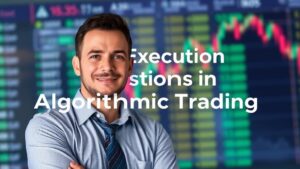Inviting Exploration of Advanced Strategies
Curious about how advanced algorithms are influencing investment strategies? Let’s dive into the mechanics of modern trading.
Did you know that the global smart contract market is expected to reach $300 million by 2023, growing at a staggering rate of around 32% annually? This explosive growth is propelled by advancements in both artificial intelligence (AI) and blockchain technologies, which together are revolutionizing how we approach investment strategies. The integration of AI and blockchain has laid the foundation for a transformative landscape where investment decisions can be automated, efficient, and transparent, eliminating traditional inefficiencies and biases.
Understanding how AI and blockchain work in tandem is crucial for investors looking to stay ahead in an increasingly digital economy. Smart contracts, which are self-executing contracts with the terms of the agreement directly written into code, are becoming a game changer in automating various aspects of investment management. In this article, we will explore the fundamentals of smart contracts, how AI enhances their capabilities, and the implications this has for automating investment strategies. We will also delve into real-world examples and statistics that underscore their significance, ensuring you gain a comprehensive understanding of this innovative intersection.
Understanding the Basics
Ai-powered smart contracts
Understanding the intersection of Artificial Intelligence (AI) and Blockchain technology is essential in grasping how these innovations collaborate to enhance investment strategies through smart contracts. At its core, AI refers to the simulation of human intelligence processes by machines, especially computer systems. It encompasses learning, reasoning, and self-correction capabilities, which can optimally analyze data and predict trends. On the other hand, Blockchain is a decentralized digital ledger that records transactions across many computers in a way that prevents alteration. This creates trust without the need for intermediaries, a feature greatly beneficial for financial transactions.
Smart contracts are self-executing contracts where the terms of the agreement between buyer and seller are directly written into lines of code. They run on blockchain networks and automatically enforce and compile obligations when predefined conditions are met. For example, an AI system can analyze historical stock market data, predict potential investment risks, and deploy funds based on these predictions–all executed through a smart contract. According to a report from Gartner, by 2025, the business value created by blockchain will exceed $360 billion annually, illustrating the growing importance of this technology in various sectors, including finance.
This synergy between AI and blockchain is particularly useful in automating investment strategies. Investors benefit from increased efficiency and reduced operational costs. Tasks that traditionally required extensive human oversight–like portfolio management and risk assessment–can now be automated. For example, AI algorithms can continuously monitor market conditions and trigger smart contracts to adjust investment allocations based on real-time data analyses. This not only minimizes human error but also enables a more responsive investment approach.
As we navigate this rapidly evolving landscape, some of the most pressing questions include concerns about security, regulation, and ethical considerations. Although blockchains decentralized nature enhances transparency and security, it is not immune to vulnerabilities. Smart contracts are coded by humans, which can lead to bugs or unforeseen exploits. So, proper auditing and adherence to regulatory frameworks are crucial for ensuring safe investment practices. By understanding these basics, stakeholders can better appreciate the transformative potential of AI and blockchain in reshaping investment strategies.
Key Components
Blockchain investment automation
The intersection of artificial intelligence (AI) and blockchain technology has paved the way for the development of smart contracts that can automate complex investment strategies. This fusion not only enhances the efficiency of executing trades but also mitigates the risks associated with human error. Understanding the key components that drive this innovative collaboration is essential for stakeholders in the financial and technology sectors.
One of the foundational elements of this integration is the use of blockchains decentralized ledger. Transactions are recorded across multiple nodes, ensuring transparency and security. For example, a smart contract can automate transactions based on predetermined conditions, such as triggering trades when certain market indicators are met. According to a report from Deloitte, smart contracts have the potential to reduce transaction costs by up to 20%, illustrating the financial benefits of leveraging blockchain for investment strategies.
Another critical component is the role of AI algorithms in analyzing market data and making quick, informed decisions. e algorithms utilize vast amounts of historical and real-time data to identify trends and patterns, thereby informing the execution of smart contracts. For example, hedge funds are increasingly employing machine learning techniques to predict price movements. A McKinsey report indicates that firms leveraging AI can achieve up to a 30% improvement in investment performance compared to traditional methods.
Plus, interoperability between various blockchain platforms and AI models is essential for maximizing the potential of automated investment strategies. This allows for seamless integration of diverse data sources and computing power, enhancing the overall efficacy of smart contracts. As more companies explore this integration, the financial landscape will be increasingly shaped by data-driven decision-making, offering a promising outlook for the future of investment automation.
Practical Applications
Automated trading strategies
In the realm of finance, the convergence of AI and blockchain technology is revolutionizing investment strategies through the implementation of smart contracts. These automated agreements allow for self-executing transactions based on pre-defined conditions, significantly enhancing efficiency and transparency. For example, an investment firm can deploy smart contracts that automatically trigger trades when specific market indicators reach a threshold, thus eliminating the need for human intervention and minimizing the potential for errors or delays.
One practical application is in the area of portfolio management. AI algorithms can analyze vast datasets to identify trends and opportunities, while smart contracts can facilitate the automated execution of trades based on these insights. A report by McKinsey & Company indicates that firms using AI in investment management can experience up to a 50% reduction in operational costs, emphasizing the financial benefits of this integration.
Also, automated investment strategies can enhance compliance and auditing processes. Smart contracts can include built-in compliance checks that automatically verify whether a trade adheres to regulatory requirements, thus mitigating risks related to non-compliance. This is particularly crucial given the increasing scrutiny surrounding financial transactions; in 2021 alone, global fines for non-compliance reached over $10 billion, illustrating the potential savings in regulatory costs.
Investors also benefit from greater trust in the system, as blockchains inherent transparency allows all parties to verify contract terms and transaction histories instantly. This trust is essential in building relationships within decentralized finance (DeFi) ecosystems, where investors engage with multiple stakeholders. By leveraging AI and blockchain, smart contracts provide a secure environment for investment, facilitating growth and innovation in financial markets.
Conclusion
Smart contract market growth
In summary, the integration of AI and blockchain technology is revolutionizing the investment landscape through the development of smart contracts that automate investment strategies. By harnessing the power of artificial intelligence, these contracts can analyze vast datasets, identify trends, and execute trades without human intervention, thereby minimizing risks and optimizing returns. The transparency and security provided by blockchain further enhance the reliability of these automated systems, fostering greater confidence among investors. Together, these technologies represent a paradigm shift in how investment strategies are conceived and implemented.
The significance of this evolution cannot be overstated. As we continue to witness the growing intersection of AI and blockchain, opportunities will emerge for not only improving efficiency but also democratizing access to investment strategies that were previously reserved for institutional investors. As the financial landscape evolves, it is imperative for both individual investors and financial institutions to embrace these innovations to stay competitive. We stand at the brink of a financial revolution; the question remains
are we ready to harness these technologies to reshape the future of investment?



